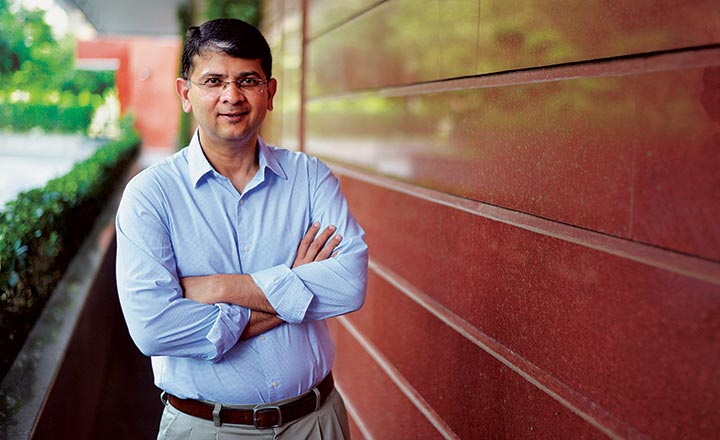When you log in to a jewellery or property website, a chat box pops up to the right corner, with a cheery, ‘Hello, what are you looking for?’. Don’t settle down for a lengthy, soulful conversation, the message is not from a person but from a bot — one of the many chatbots that seem to be everywhere. The man behind them, Beerud Sheth, CEO and co-founder of Gupshup, expects India to be a chatbot-heavy country as soon as SMS messaging and WhatsApp opens up to the potential of chatbots. Incidentally, WhatsApp allowed Gupshup, the messaging and chatbot integration platform, to integrate its APIs with WhatsApp Business to gain enterprise customers this August.
“Enterprises like to go where customers are. Banks moved from branches to ATMs, and now to mobile phones. Similarly, when consumers moved to WhatsApp from other messaging platforms, enterprises have to follow. We offer one API to reach out to any channel — be it SMS, Facebook Messenger, Twitter or WhatsApp. Our single solution can be used by messaging services across the world, be it Wechat or WhatsApp,” says Ravi Sundararajan, chief operating officer, Gupshup.
WhatsApp has selected five players from across the globe including Gupshup, which sends around 4.5 billion messages every month for its enterprise clients. Sundararajan feels that WhatsApp will continue to be choosy about who they work with. “WhatsApp, too, does not want its users to wake up and have 500 messages in the morning. That will spoil the user experience. They will hence tread carefully, and go only with certain brands. It will be a huge opportunity for us because we offer messaging through multiple channels,” he says.
Chatbots, which work like virtual assistants on instant messaging platforms, are already present in India through customer service agents and companies. Gradually, consumers are getting used to chatting with bots, asking questions pertaining to banking, e-commerce marketplaces and other customer-oriented sectors. Sheth believes an explosion is soon to happen, and by virtue of being one of the first movers in the SMS management and chatbot space, Gupshup is likely to benefit majorly from this shift.
Starting off
Sheth, an IIT Bombay and IIM-A alumnus, founded Gupshup in 2004. Those were the days when SMS was the only channel of messaging for most people. Gupshup offered messaging management services to companies in India. “We are the largest platform for SMS,” he states. “Today, most of your SMSes from banks, Ola or Uber are routed through us. It is a very high-volume business.”
Gupshup started toying with the idea of chatbots only four years ago. “Chatbots are just an advanced extension of SMS. When you swipe a credit card, you get an instant message that money has been debited from your account. What if a customer could also enquire through the same way about his credit limit and other details? For the bank, it would be hard to answer millions of such messages. That’s where chatbots can help, by responding automatically to such queries,” says Sheth.
While Gupshup builds chatbots for their enterprise customers, it also allows independent developers to use their platform and develop bots for themselves or their clients. According to the company, the idea is to become ubiquitous amongst enterprise and developer communities. Sheth explains, “The way to scale up a technology is by opening it up and allowing independent developers to tinker with it. Then, you can have thousands of customers and many developers working on solutions. Otherwise, you can have only as many customers as the number of staff. As of now, a total of 30,000 chatbots have been built on Gupshup.”
Creating a technology, however, is only half the job done. Equally crucial is the ability to market and sell it. “Winning over people to a new idea is always challenging. As an entrepreneur, you have to find early adopters. You don’t sell to everyone. For us, luckily, organisations such as Yes Bank, ICICI Bank and HDFC Bank were eager to adopt the new technology,” says Sheth.
Gupshup’s customers have deployed chatbots to answer simple queries such as on product or service availability, these are called structured conversations. Bots can also be programmed to have more complex ‘unstructured conversations’. “I am fairly confident that chatbots will become smarter as data becomes easily available. We are about two to three years from chatbots being able to solve complex problems,” says Aakrit Vaish, CEO of Haptik, a conversational AI platform that also builds chatbots. “We started with two but today we work with 35 customers,” he says.
Sheth believes, technology has advanced but developers are yet to catch up, and are not using all of the abilities that the AI engine is capable of. While Gupshup competes with Haptik in the chatbot space, there is no real competition for its messaging service. Even with chatbots, Gupshup has a competitive advantage owing to its long-term enterprise partnerships.
Globally, Gupshup presently competes with US-based Twilio — a cloud communications platform founded in 2008. However, more competition may be on its way, with Amazon, Google, Facebook and Microsoft building their own chatbot platforms. Additionally, the big companies have the advantage of superior AI-based engineering, which would produce far more accomplished chatbots.
Sheth, however, is not losing sleep about it just yet. He says, “They are good at what they do. But, that does not have an impact on a retailer or a restaurant. For general-purpose AI, they are good. But enterprises need specific training data such as transaction records in a bank, or order history in a restaurant.” He claims that he has this data on local businesses, which the bigger players do not have.
Gupshup’s enterprise clients provide them with all the data to develop the bots. In fact, Microsoft and Google have partnered with Gupshup to equip its developers to build bots for their interactive services. Research firm MarketsandMarkets, which evaluated 250 companies across the world providing bot services, places Gupshup alongside Microsoft, Facebook, Google and IBM as companies that have the maximum influence in the field of bots.
Betting on bots
Yes Bank has been an early adopter of Gupshup’s chatbot technology. Through this, a user can check account balance, recent transactions, transfer money, pay bills, check loan eligibility, hotlist debit cards and apply for 60+ Yes Bank products and services through ‘Yes Robot’. Sai Giridhar, senior president and head of consumer retail lending at Yes Bank states, “Through Yes mPower bot, we were able to automate and efficiently reduce the time taken to process loans.”
Among other clients, Gupshup enables IndusInd Bank’s customers to track account balances, view mini statements, reward points and other notifications on WhatsApp. Even Kotak Mahindra Bank sends its account opening kit videos to customers who opt for WhatsApp-based communication. Users can now also place statement or cheque-book requests, and get questions answered through the chatbot.
If banks later want bots to access information outside their database, Gupshup has also launched the world’s first bot-to-bot communication platform InterBot through which developers can create bots that communicate, collaborate and transact with fellow bots. This can give significant complexity and versatility to chatbots, including referring sources outside a company’s database.
However, Haptik’s Vaish believes that chatbots have not yet been deployed at a scale where they prove cost-effective for companies, with most still experimenting and running it alongside conventional customer-care setups.
Yatin Verma, vice president of Aptech, says, “We have centres across 40 countries. Using this chatbot helps us answer students’ queries across different time zones, and be available 24x7. The queries are mostly repetitive, hence we started using a chatbot. Email and phone-based enquiries have come down by around 10%.” According to Gupshup, chatbots offer customers a consistent quality of service. “A chatbot can explain a product way better than an employee who has joined only a week back, and has not yet understood your product well,” explains Sheth.
Vaish, meanwhile, believes that chatbot adoption is just getting started. “This is year zero. WhatsApp has just opened up their platform for a select few businesses. Eventually, every business is going to be on WhatsApp, communicating directly with their customers,” he adds.
On the back of such success, Gupshup clocked Rs.5 billion revenue in FY18. Most of this comes from messaging services, where they charge customers for every message. Additionally, they charge a fee to help enterprises build bots. Gupshup’s base of about 500 enterprise customers include Citibank, DishTV, ICICI Bank, Flipkart, Titan and Infosys, apart from the 36,300 developers using its platform. The chatbot community is still at a nascent stage, and the company expects to grow 25-30% every year for the next five years, driven by increasing chatbot adoption by existing customers.
According to the report by MarketsandMarkets, the market size of bot services stood at about $357 million in 2016, and is expected to grow at an annual compounded growth rate of 31% to reach $1.78 billion by end-2022. With more businesses across the globe taking to using bots and for multiple reasons, the future seems bright for Gupshup. “We have a headstart already, since no other player right now has existing relationships with prospective customers in the chatbot space,” Sheth says with a smile.











